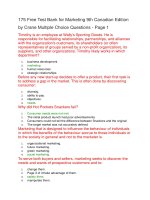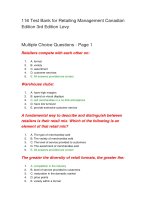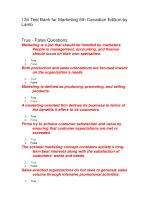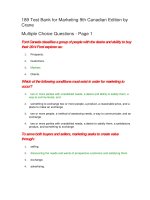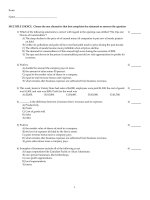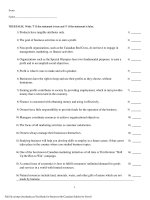Download PDF test bank for macroeconomics 14th canadian edition by ragan
Bạn đang xem bản rút gọn của tài liệu. Xem và tải ngay bản đầy đủ của tài liệu tại đây (500.04 KB, 47 trang )
Test Bank for Macroeconomics Fourteenth Canadian
Edition 14th Edition by Ragan
Chapter 1
Economic Issues and Concepts
1) Which of the following statements provides the best definition of economics?
A) The study of the most equitable distribution of scarce resources.
B) The study of the use of scarce resources to satisfy unlimited human wants.
C) The study of the production of goods and services.
D) The study of the productive capacity of a nation's factors of
production. E) The study of production and increasing its efficiency.
Answer: B
Diff: 1
Topic: 1.1a. economics/resources
Skill: Recall
Objective: NEW
User2: Qualitative
2) Society's resources are often divided into broad categories. They are
A) goods and services.
B) factors of consumption.
C) land, labour, and capital.
D) population and natural resources.
E) tangible commodities and intangible
commodities. Answer: C
Diff: 1
Topic: 1.1a. economics/resources
Skill: Recall
Objective: NEW
User2: Qualitative
3) Consider the following list: a worker with training in video gaming technology, 10 hectares
of arable land in southern Ontario, a fishing trawler in Nova Scotia, an ice-cream truck at a park
in Quebec. Each of these is an example of
A) a factor of production.
B) a capital resource.
C) a commodity.
D) goods and services.
E) an economic
service. Answer: A
Diff: 1
Topic: 1.1a. economics/resources
Skill: Applied
User2: Qualitative
1
Copyright © 2014 Pearson Canada, Inc.
4) A basic underlying point in economics is that
A) people have unlimited wants in the face of limited resources.
B) there are unlimited resources.
C) governments should satisfy the needs of the people.
D) people have limited wants in the face of limited resources.
E) governments should never interfere in the workings of a market economy.
Answer: A
Diff: 1
Topic: 1.1b. scarcity and choice
Skill: Recall
User2: Qualitative
5) Which of the following best describes the study of
economics? A) how to plan an economy
B) how to limit human wants so that scarce resources are
sufficient C) why resources are scarce
D) the allocation of scarce resources among alternative uses
E) how to distribute income as equally as possible Answer:
D
Diff: 1
Topic: 1.1b. scarcity and choice
Skill: Recall
Objective: REVISED
User2: Qualitative
6) Economics can best be described as
A) the study of how a society ought to allocate its resources.
B) the study of the use of scarce resources to satisfy unlimited human wants.
C) the application of sophisticated mathematical models to address social problems.
D) a normative science.
E) the study of how to reduce inflation and unemployment.
Answer: B
Diff: 1
Topic: 1.1b. scarcity and choice
Skill: Recall
User2: Qualitative
2
Copyright © 2014 Pearson Canada, Inc.
7) Scarcity is likely to be
A) a problem that will be solved by the proper use of available resources.
B) unique to the twentieth century.
C) a problem that will always exist.
D) a result of the work ethic.
E) eliminated with a better understanding of economics.
Answer: C
Diff: 2
Topic: 1.1b. scarcity and choice
Skill: Applied
User2: Qualitative
8) The concept of scarcity in economics usually refers to a condition
A) where society is not employing all of its available resources in an efficient manner.
B) where people's wants can never be satisfied by the available resources.
C) that afflicts only poor countries.
D) where too many frivolous goods and services are produced at the expense of socially
desirable goods and services.
E) where production is efficient, but distribution is inefficient.
Answer: B
Comment: An algorithmic version of this question appears in MyEconLab
Diff: 2
Topic: 1.1b. scarcity and choice
Skill: Recall
User2: Qualitative
9) Which of the following statements best describes the underlying feature in most
economic problems?
A) People have unlimited wants in the face of limited
resources. B) There are unlimited resources.
C) Our country is rich; we just don't realize it.
D) People have limited wants in the face of limited resources.
E) Governments should never interfere in the workings of a market
economy. Answer: A
Diff: 1
Topic: 1.1b. scarcity and choice
Skill: Recall
User2: Qualitative
3
Copyright © 2014 Pearson Canada, Inc.
10) Because resources are scarce, individuals are required
to A) make choices among alternatives.
B) use resources inefficiently.
C) sacrifice production but not
consumption. D) improve distribution but
not production. E) improve production but
not distribution. Answer: A
Comment: An algorithmic version of this question appears in MyEconLab
Diff: 2
Topic: 1.1b. scarcity and choice
Skill: Recall
User2: Qualitative
4
Copyright © 2014 Pearson Canada, Inc.
FIGURE 1-1
With a budget of $200 million, the government can choose to purchase 4 helicopters or repair
200 km of highway.
11) Refer to Figure 1-1. For the government, the opportunity cost of one search and rescue
helicopter is
A) 0 kilometres of highway repair.
B) 50 kilometres of highway repair.
C) 100 kilometres of highway repair.
D) 150 kilometres of highway repair.
E) 200 kilometres of highway repair.
Answer: B
Diff: 2
Topic: 1.1c. opportunity cost
Skill: Applied
User1: Graph
User2: Quantitative
5
Copyright © 2014 Pearson Canada, Inc.
12) Refer to Figure 1-1. For the government, the opportunity cost of one kilometre of highway
repair is
A) 1 search and rescue helicopter.
B) 1/2 of a search and rescue helicopter.
C) 1/10 of a search and rescue helicopter.
D) 1/50 of a search and rescue helicopter.
E) 1/100 of a search and rescue
helicopter. Answer: D
Diff: 3
Topic: 1.1c. opportunity cost
Skill: Applied
User1: Graph
User2: Quantitative
13) Refer to Figure 1-1. If the government chooses to allocate all $200 million to highway
repair, we can say that
A) the opportunity cost of the highway repair is uncertain.
B) the opportunity cost of the highway repair is $0.
C) the opportunity cost of the highway repair is 4 search and rescue helicopters.
D) there is no opportunity cost involved because the government has achieved its
objectives. E) there is no opportunity cost involved because the government stayed within
its budget. Answer: C
Comment: An algorithmic version of this question appears in MyEconLab
Diff: 2
Topic: 1.1c. opportunity cost
Skill: Applied
User1: Graph
User2: Quantitative
14) Refer to Figure 1-1. Which of the following combinations of kilometres of highway
repair and helicopters is unaffordable, given the government's budget of $200 million?
A) B B) D
C) E D) F
E) G
Answer: E
Diff: 1
Topic: 1.1c. opportunity cost
Skill: Applied
User1: Graph
User2: Qualitative
6
Copyright © 2014 Pearson Canada, Inc.
With a budget of $500 000, a school board can choose to purchase 20 000 textbooks or 2000
laptop computers (or some intermediate combination) for use in classrooms.
Figure 1-2
15) Refer to Figure 1-2. For the school board, what is the opportunity cost of one additional
laptop computer?
A) 0 textbooks
B) 1/10 of a textbook
C) 10 textbooks
D) 20 textbooks
E) 2000 textbooks
Answer: C Diff: 2
Topic: 1.1c. opportunity cost
Skill: Applied
Objective: NEW
User1: Graph
User2: Quantitative
7
Copyright © 2014 Pearson Canada, Inc.
16) Refer to Figure 1-2. For the school board, what is the opportunity cost of one additional
textbook?
A) 2000 laptops B)
1000 laptops C)
1/100 of a laptop D)
1/1000 of a laptop E)
1/10 of a laptop
Answer: E
Diff: 2
Topic: 1.1c. opportunity cost
Skill: Applied
Objective: NEW
User1: Graph
User2: Quantitative
17) Refer to Figure 1-2. Suppose the school board chooses to allocate all $500 000 to the
purchase of laptop computers. What is the opportunity cost of this entire purchase?
A) The opportunity cost is 2000 laptops.
B) The opportunity cost is 20,000 textbooks.
C) The opportunity cost is uncertain.
D) The opportunity cost is $0.
E) There is no opportunity cost because the purchase was made within the available budget.
Answer: B
Diff: 2
Topic: 1.1c. opportunity cost
Skill: Applied
Objective: NEW
User1: Graph
User2: Quantitative
18) Refer to Figure 1-2. Which of the following combinations of textbooks and laptops is
unaffordable, given the school board's budget of $500 000?
A) A B) B
C) C D) D
E) E
Answer: D
Diff: 1
Topic: 1.1c. opportunity cost
Skill: Applied
Objective: NEW
User1: Graph
User2: Quantitative
8
Copyright © 2014 Pearson Canada, Inc.
19) Refer to Figure 1-2. What is the price of a textbook in this example?
A) $25
B) $40 C)
$50 D) $100
E) $250
Answer: A
Diff: 1
Topic: 1.1c. opportunity cost
Skill: Applied
Objective: NEW
User1: Graph
User2: Quantitative
20) Refer to Figure 1-2. What is the price of a laptop computer in this
example? A) $25
B) $40 C)
$50 D)
$100 E)
$250
Answer: E
Diff: 1
Topic: 1.1c. opportunity cost
Skill: Applied
Objective: NEW
User1: Graph
User2: Quantitative
9
Copyright © 2014 Pearson Canada, Inc.
The table below illustrates that, in one day, Tristan can produce either 12 fishing lures or mow 3
lawns, while Thomas can produce either 6 fishing lures or mow 6 lawns.
Tristan
Thomas
Fishing Lures
12
6
Mowed
Lawns
3
6
TABLE 1-1
21) Refer to Table 1-1. What is Tristan's opportunity cost of producing one fishing lure?
A) one mowed lawn
B) 3 mowed lawns
C) 1/3 of a mowed lawn
D) 1/4 of a mowed lawn
E) 4 mowed lawns
Answer: D
Diff: 2
Topic: 1.1c. opportunity cost
Skill: Applied
User1: Table
User2: Quantitative
22) Refer to Table 1-1. What is Thomas's opportunity cost of producing one fishing
lure? A) 5 lures
B) 1 mowed lawn
C) 1/6 of a lure
D) 1/6 of a mowed lawn
E) there is no opportunity cost
Answer: B
Diff: 2
Topic: 1.1c. opportunity cost
Skill: Applied
User1: Table
User2: Quantitative
10
Copyright © 2014 Pearson Canada, Inc.
23) Refer to Table 1-1. What is Tristan's opportunity cost of producing one mowed
lawn? A) one fishing lure
B) 3 fishing lures
C) 4 fishing lures
D) 6 fishing lures
E) 12 fishing lures
Answer: C Diff: 2
Topic: 1.1c. opportunity cost
Skill: Applied
User1: Table
User2: Quantitative
24) Refer to Table 1-1. What is Thomas's opportunity cost of producing one mowed
lawn? A) 0 fishing lures
B) 1/6 fishing lure
C) one fishing
lure D) 6 fishing
lures E) 12 fishing
lures Answer: C
Diff: 2
Topic: 1.1c. opportunity cost
Skill: Applied
User1: Table
User2: Quantitative
25) Refer to Table 1-1. If Tristan and Thomas want to maximize their joint output from one day
of work, how should they specialize their production?
A) Tristan produces 3 mowed lawns; Thomas produces 6 mowed lawns
B) Tristan produces 6 lures; Thomas produces 6 lures
C) Tristan produces 6 lures and 3 mowed lawns
D) Tristan produces 12 lures; Thomas produces 6 mowed lawns
E) Tristan produces nothing, Thomas produces 6 lures and 6 mowed
lawns Answer: D
Diff: 3
Topic: 1.1c. opportunity cost
Skill: Applied
User1: Table
User2: Quantitative
11
Copyright © 2014 Pearson Canada, Inc.
26) Refer to Table 1-1. Which of the following statements about Tristan's and
Thomas's opportunity costs is correct?
A) Tristan has a higher opportunity cost of producing mowed lawns.
B) Thomas has a higher opportunity cost of producing mowed lawns.
C) Tristan has a higher opportunity cost of producing fishing lures.
D) Thomas has a higher opportunity cost of producing fishing lures.
E) Both A and D are correct.
Answer: E
Diff: 3
Topic: 1.1c. opportunity cost
Skill: Applied
User1: Table
User2: Qualitative
12
Copyright © 2014 Pearson Canada, Inc.
Madeleine allows herself $100 per month for purchasing coffee. The diagram below illustrates
the choices available to her.
FIGURE 1-3
27) Refer to Figure 1-3. For Madeleine, the opportunity cost of one regular coffee is
A) 1/4 of a regular coffee.
B) 20 lattes.
C) 4 lattes.
D) 1/4 of a latte.
E) 80 lattes.
Answer: D Diff:
2
Topic: 1.1c. opportunity cost
Skill: Applied
User1: Graph
User2: Quantitative
28) Refer to Figure 1-3. For Madeleine, the opportunity cost of one latte is
A) 1/4 of a regular coffee.
B) 1/4 of a latte.
C) 8 regular coffees.
D) 80 regular coffees.
E) 4 regular coffees.
Answer: E
Diff: 2
Topic: 1.1c. opportunity cost
Skill: Applied
User1: Graph
User2: Quantitative
13
Copyright © 2014 Pearson Canada, Inc.
29) Refer to Figure 1-3. If Madeleine chooses to allocate all $100 to buying lattes, we can say
that her opportunity cost in one month is
A) zero because she bought what she desired.
B) zero because she stayed within her budget.
C) 80 cups of regular coffee.
D) 40 cups of regular
coffee. E) 20 cups of regular
coffee. Answer: C
Diff: 2
Topic: 1.1c. opportunity cost
Skill: Applied
User1: Graph
User2: Quantitative
30) Refer to Figure 1-3. Which of the following combinations of regular coffees and lattes is
affordable over the one-month period, given Madeleine's budget?
A) 15 lattes and 30 coffees
B) 16 lattes and 16 coffees
C) 8 lattes and 50 coffees
D) 4 lattes and 66 coffees
E) 20 lattes and 80 coffees
Answer: B
Diff: 3
Topic: 1.1c. opportunity cost
Skill: Applied
User1: Graph
User2: Quantitative
14
Copyright © 2014 Pearson Canada, Inc.
The table below shows that, in one day, Claire can complete either 3 chemistry or 2 biology
lab reports, while Sam can complete either 4 chemistry or 3 biology lab reports.
Chemistry Lab
Reports
3
4
Claire
Sam
Biology Lab Reports
2
3
TABLE 1-2
31) Refer to Table 1-2. What is Claire's opportunity cost of completing 1 chemistry lab report?
A)
of a biology lab report
B) 1biology lab reports
C)
of a biology lab report
D) 2 biology lab reports
E) 3 biology lab reports
Answer: A
Comment: An algorithmic version of this question appears in MyEconLab
Diff: 2
Topic: 1.1c. opportunity cost
Skill: Applied
User1: Table
User2: Quantitative
32) Refer to Table 1-2. What is Sam's opportunity cost of completing 1 chemistry lab report?
A) 4 of a biology lab report
B) 3 of a biology lab report
C)
of a biology lab report
D)
of a biology lab report
E)
of a biology lab report
Answer: E
Diff: 2
Topic: 1.1c. opportunity cost
Skill: Applied
User1: Table
User2: Quantitative
15
Copyright © 2014 Pearson Canada, Inc.
33) Refer to Table 1-2. What is Sam's opportunity cost of completing 3 biology lab reports?
A) 0 chemistry lab reports
B) 1 chemistry lab reports
C) 2 chemistry lab reports
D) 3 chemistry lab reports
E) 4 chemistry lab reports
Answer: E
Diff: 2
Topic: 1.1c. opportunity cost
Skill: Applied
User1: Table
User2: Quantitative
34) Refer to Table 1-2. What is Sam's opportunity cost of completing 2 biology lab reports?
A) 1
chemistry lab reports
B)
of a chemistry lab report
C)
of a chemistry lab report
D) 2 chemistry lab reports
E) 4 chemistry lab reports
Answer: D
Diff: 3
Topic: 1.1c. opportunity cost
Skill: Applied
User1: Table
User2: Quantitative
35) Refer to Table 1-2. Which of the following statements about Claire's and Sam's opportunity
costs is correct?
A) Claire has a higher opportunity cost for completing 1 biology lab report. B)
Sam has a higher opportunity cost for completing 1 biology lab report.
C) Claire has a higher opportunity cost for completing 1 chemistry lab
report. D) Sam has a lower opportunity cost for completing 1 chemistry lab
report. E) Claire and Sam have equal opportunity costs.
Answer: A
Diff: 3
Topic: 1.1c. opportunity cost
Skill: Applied
User1: Table
User2: Quantitative
16
Copyright © 2014 Pearson Canada, Inc.
36) Scarcity arises from limited resources. For this reason, all economic choices
involve A) a value judgement.
B) pride.
C) an opportunity cost.
D) complementary
ends. E) greed.
Answer: C
Diff: 2
Topic: 1.1c. opportunity cost
Skill: Recall
User2: Qualitative
37) The opportunity cost of going to college or university for four years is
A) equal to the wage rate a person will earn after graduation.
B) the least valued alternative one forfeits to attend.
C) the cost of tuition and books and four years of lost wages from employment.
D) the cost of tuition, residence fees and books.
E) zero.
Answer: C
Diff: 2
Topic: 1.1c. opportunity cost
Skill: Applied
User2: Qualitative
38) Suppose there are only three alternatives to attending a "free" social event: read a novel
(you value this at $10), go to work (you could earn $20), or watch videos with some friends
(you value this at $25). The opportunity cost of attending the social event is
A) $10.
B) $20.
C) $25.
D) $45.
E) $55.
Answer: C
Diff: 2
Topic: 1.1c. opportunity cost
Skill: Applied
Objective: REVISED
User2: Quantitative
17
Copyright © 2014 Pearson Canada, Inc.
39) The opportunity cost of producing good A is defined to be
A) the money cost of the factors of production used in good
A. B) the retail price of good A.
C) the cheapest method of producing good A.
D) what must be sacrificed of other goods to get an additional unit of good A.
E) the cost of having to get by using something else in place of good A.
Answer: D
Diff: 1
Topic: 1.1c. opportunity cost
Skill: Applied
User2: Qualitative
40) Suppose that one unit of labour can produce either 5 units of wool or 2 pineapples. What is
the opportunity cost of producing 1 pineapple?
A) 5 units of wool
B) 2 units of wool
C) 2/5 unit of wool
D) 5/2 units of
wool E) zero
Answer: D
Diff: 2
Topic: 1.1c. opportunity cost
Skill: Applied
User2: Quantitative
41) A small landscaping firm purchases a tractor that, in one day, is capable of drilling 60
fence-post holes or removing 12 tree stumps (or some intermediate combination). For
this landscaper, what is the opportunity cost of removing one extra tree stump?
A) 1/12th of the cost of the tractor
B) 1/5 of the cost of the tractor C)
drilling 12 fence-post holes D)
drilling 5 fence-post holes
E) there is no opportunity cost
Answer: D
Diff: 1
Topic: 1.1c. opportunity cost
Skill: Applied
Objective: NEW
User2: Quantitative
18
Copyright © 2014 Pearson Canada, Inc.
42) Suppose that a bakeshop with 5 employees can produce both pies and cakes. In one day, if all
resources are devoted to baking pies, the shop can produce 125 pies; if all resources are devoted
to baking cakes, the shop can produce 50. What is the shop's opportunity cost of producing any
one cake?
A) 0.4 pies
B) 0.25 pies
C) 2.5 pies
D) 0.4 cakes
E) 2.5 cakes
Answer: C
Diff: 1
Topic: 1.1c. opportunity cost
Skill: Applied
User2: Quantitative
43) Suppose that a bakeshop with 5 employees can produce both pies and cakes. In one day, if all
resources are devoted to baking pies, the shop can produce 125 pies; if all resources are devoted
to baking cakes, the shop can produce 50. What is the shop's opportunity cost of producing any
one pie?
A) 125 pies
B) 0.4 cakes
C) 2.5 pies
D) 0.4 pies
E) 50 cakes
Answer: B
Diff: 1
Topic: 1.1c. opportunity cost
Skill: Applied
Objective: NEW
User2: Quantitative
44) Katie and Hugh are producing pies and jars of pickles. Katie can produce either 200 jars
of pickles or 100 pies per month. Hugh can produce either 800 jars of pickles or 200 pies per
month. Which of the following statements is correct?
A) Katie's opportunity cost of producing 1 jar of pickles is 2 pies.
B) Katie's opportunity cost of producing 1 jar of pickles is 1/2 of a pie.
C) Hugh's opportunity cost of producing 1 jar of pickles is 4 pies.
D) Hugh's opportunity cost of producing 1 pie is 1/4 jar of pickles.
E) Hugh's and Katie's opportunity costs of producing are the
same. Answer: B
Diff: 3
Topic: 1.1c. opportunity cost
Skill: Applied
Objective: REVISED
User2: Quantitative
19
Copyright © 2014 Pearson Canada, Inc.
45) Suppose Andrea has a job that pays her $25 000 per year (after taxes). She is considering
quitting her job and going to university full time for four years. Tuition fees and books will cost
$12 000 per year. Living expenses in either situation will cost $10 000 per year. What is the
opportunity cost of Andrea's four-year university degree?
A) $88 000
B) $100 000
C) $120 000
D) $148 000
E) $188 000
Answer: D
Diff: 3
Topic: 1.1c. opportunity cost
Skill: Applied
User2: Quantitative
46) It has been observed that university enrollment in Canada is higher during periods of
high unemployment. A possible explanation for this is that
A) when prospects for getting a job are poor, the opportunity cost of getting a job is lower.
B) when prospects for getting a job are poor, the opportunity cost of doing nothing is
higher. C) during periods of high unemployment, tuition fees are reduced.
D) during periods of high unemployment, the opportunity cost is no longer relevant.
E) when prospects for getting a job are poor, the opportunity cost of going to university is
lower. Answer: E
Diff: 2
Topic: 1.1c. opportunity cost
Skill: Applied
User2: Qualitative
47) Chantal has a full-time job as a geological engineer and earns an annual after-tax salary of
$85 000. She decides to leave her job for 6 months to scuba dive on the Great Barrier Reef in
Australia, and incurs costs of $7500 for course equipment and certification, $2500 for
airfare, and $12 000 for regular living expenses in Australia (equal to her living expenses at
home). What is Chantal's opportunity cost for this 6-month, unpaid leave of absence?
A) $12 000
B) $22 000
C) $42 000
D) $52 500
E) $65 000
Answer: D
Diff: 3
Topic: 1.1c. opportunity cost
Skill: Applied
Objective: NEW
User2: Quantitative
20
Copyright © 2014 Pearson Canada, Inc.
48) During economic recessions, the opportunity cost of going to university ________ because
the wages a student can expect to earn working in the best alternative ________.
A) increases; decrease
B) decreases; increase
C) increases; increase
D) decreases; decrease
E) remains the same; remain the same
Answer: D
Diff: 2
Topic: 1.1c. opportunity cost
Skill: Applied
Objective: NEW
User2: Qualitative
49) A country's production possibilities boundary shows that
A) when a society combines its resources efficiently, it cannot produce more of one good without
producing less of the other good.
B) when a society combines its resources inefficiently, it cannot produce more of one good
without producing less of the other good.
C) when a society combines its resources efficiently, it is always possible to produce more of
all goods.
D) all points inside the boundary are preferred to all points on the boundary.
E) the supply for goods always exceeds the demand.
Answer: A
Diff: 2
Topic: 1.1d. production possibilities boundary
Skill: Applied
User2: Qualitative
50) Consider a production possibilities boundary showing the possible combinations of military
goods and civilian goods that a country can produce. Suppose that the country is currently at a
point on the boundary. If the production of military goods is increased, the production of civilian
goods will necessarily
A) decrease.
B) remain the same.
C) increase.
D) increase at a decreasing
rate. E) increase at a increasing
rate. Answer: A
Diff: 2
Topic: 1.1d. production possibilities boundary
Skill: Applied
User2: Qualitative
21
Copyright © 2014 Pearson Canada, Inc.
51) A point lying inside the production possibilities boundary is one at
which A) there is no scarcity.
B) the opportunity cost of producing more output is negative.
C) it is not possible to produce more output with existing
resources. D) the economy has run out of resources.
E) more output could be produced with existing resources.
Answer: E
Diff: 2
Topic: 1.1d. production possibilities boundary
Skill: Applied
User2: Qualitative
52) If a country's production possibilities boundary is drawn as a straight (downward-sloping)
line it indicates
A) decreasing opportunity cost of producing more of either good.
B) the use of the scarce resources in an economy.
C) constant opportunity cost of producing more of either good.
D) an unfair distribution of resources in an economy.
E) increasing opportunity cost of producing more of either
good. Answer: C
Diff: 3
Topic: 1.1d. production possibilities boundary
Skill: Applied
User2: Qualitative
22
Copyright © 2014 Pearson Canada, Inc.
The diagram below shows two production possibilities boundaries for Country X.
FIGURE 1-4
53) Refer to Figure 1-4. The production possibilities boundaries are drawn concave to the origin.
What does this shape of the PPB demonstrate?
A) the decreasing opportunity cost of producing more of either
good B) the scarcity of resources in the economy
C) the constant opportunity cost of producing more of either good
D) the unfair distribution of resources in the economy
E) the increasing opportunity cost of producing more of either
good Answer: E
Diff: 3
Topic: 1.1d. production possibilities boundary
Skill: Applied
Objective: REVISED
User1: Graph
User2: Qualitative
23
Copyright © 2014 Pearson Canada, Inc.
54) Refer to Figure 1-4. If Country X, constrained by the production possibilities boundary PPB1, is
producing the combination of goods indicated at point F, it can produce more consumer
goods by moving to one of the points
A) A or E.
B) D or E
C) A, B, or C.
D) A or B, but not C.
E) A, B, C, D, or E.
Answer: C Diff: 3
Topic: 1.1d. production possibilities boundary
Skill: Applied
User1: Graph
User2: Qualitative
55) Refer to Figure 1-4. If Country X is currently producing at point A, it could move to point B
if
A) the cost of producing capital goods were to increase.
B) some resources were switched from the capital goods industries to the consumer
goods industries.
C) the cost of producing consumer goods were to increase.
D) some resources were switched from the consumer goods industries to the capital goods
industries.
E) Country X is no longer able to produce the quantity of capital goods at point
A. Answer: B
Diff: 2
Topic: 1.1d. production possibilities boundary
Skill: Applied
User1: Graph
User2: Qualitative
56) Refer to Figure 1-4. If Country X were producing at point C,
A) the opportunity cost of moving to point B is to give up some consumption goods.
B) the opportunity cost of moving to point A is zero.
C) the opportunity cost of moving to point A is to give up some capital goods.
D) this is the maximum output possible from given resources.
E) it is not possible to move to any point on PPB1 or PPB2 without technological progress.
Answer: B
Diff: 3
Topic: 1.1d. production possibilities boundary
Skill: Applied
User1: Graph
User2: Qualitative
24
Copyright © 2014 Pearson Canada, Inc.
57) Refer to Figure 1-4. At point B,
A) the price of capital goods is higher than the price of consumer goods.
B) Country X is producing too many consumer goods and too few capital goods.
C) the price of consumer goods is equal to the price of capital goods.
D) the opportunity cost of producing an extra unit of capital goods is higher than at point A.
E) the opportunity cost of producing an extra unit of consumer goods is higher than at point
A. Answer: E
Diff: 3
Topic: 1.1d. production possibilities boundary
Skill: Applied
User1: Graph
User2: Qualitative
58) Refer to Figure 1-4. If Country X, constrained by the production possibilities boundary PPB1,
is currently producing at point A, it can produce more capital goods by moving to point
A) F.
B) E.
C) D.
D) C.
E) B.
Answer: A
Diff: 2
Topic: 1.1d. production possibilities boundary
Skill: Applied
User1: Graph
User2: Qualitative
59) Refer to Figure 1-4. Suppose that Country X is currently producing at point E. Country X
could achieve production at point D if
A) the given resources were fully employed.
B) the given resources were more efficiently employed.
C) sufficient improvements in technology occurred in either the capital goods industry or the
consumer goods industries.
D) firms reduced output of capital goods.
E) the prices of capital goods and consumption goods
fell. Answer: C
Diff: 3
Topic: 1.1d. production possibilities boundary
Skill: Applied
User1: Graph
User2: Qualitative
25
Copyright © 2014 Pearson Canada, Inc.
